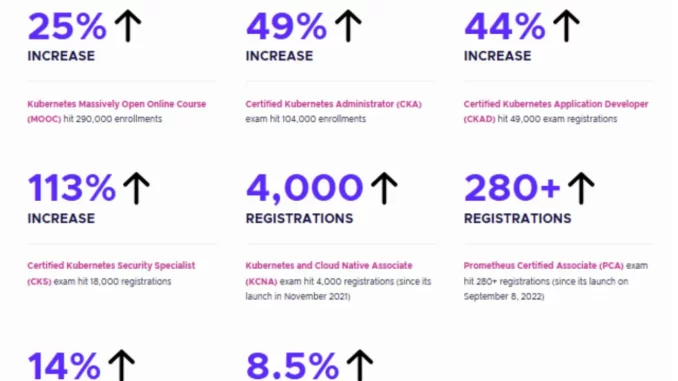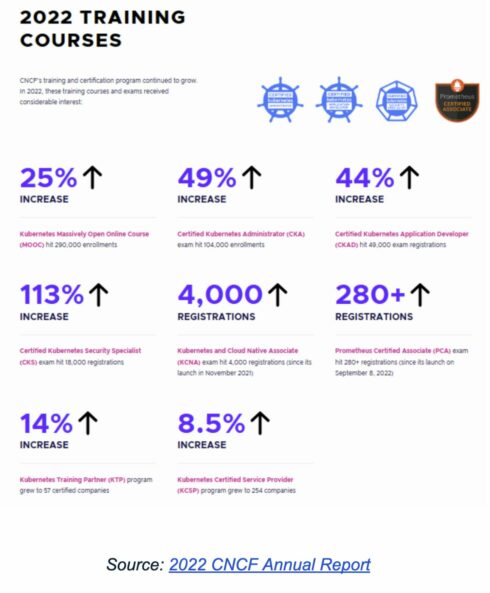


With so many newcomers to the cloud-native computing space it’s only to be expected that an ecosystem of certifications and accreditations has cropped up around Kubernetes over the years. And as demand for K8s expertise continues to grow, so does the number of professionals seeking out these certifications and accreditations.
In fact, you’d be hard-pressed to find an open-source software project that has seen more rapid developer adoption in the past decade. However, K8s’ ascent to ubiquity hasn’t been without its challenges. And as one might imagine, with such a sudden influx of newly minted developers, K8s adoption has come with some growing pains.
Its widespread appropriation has transformed how developers deploy and manage applications. However, the language continues to suffer from some common misconceptions — especially that it is overly complex and unwieldy in production, and not enterprise ready.
In fact, in a 2021 survey of IT professionals, a stunning 100% of respondents whose organizations are using or planning to use Kubernetes said that they were facing challenges with adoption, with the most commonly cited challenges being a lack of IT resources, difficulty scaling, and struggling to keep up with advancements in underlying technologies. However, what these findings fail to recognize is that much of these perceived shortcomings and challenges are not necessarily inherent to Kubernetes itself. Instead, as we’ll outline below, many of these challenges stem from some fundamental misunderstandings of how to approach and conceptualize the K8s system.
The #1 mistake
The single most widespread and detrimental mistake developers make when working in Kubernetes is actually one of mindset — the all-too-common mistake of bringing monolithic logic into the cloud-native space. Kubernetes offers a plethora of abstractions and resources designed for the cloud-native ecosystem. Failing to leverage these resources appropriately can lead to scalability issues, maintenance challenges, and inefficient application and database deployments. This misconception can also foster the belief that Kubernetes and the cloud-native paradigm are unsuitable for enterprise use, while in reality, it highlights the necessity of adapting application architectures to harness the full power of containers and orchestration.
To remedy this common mistake, teams should embed strong architecture expertise into their development processes. Having engineers with cloud-native experience can guide teams to success and help them avoid common pitfalls. This approach emphasizes the importance of understanding and adapting to the unique characteristics of Kubernetes and cloud-native development.
Cloud-native thinking
The best way to avoid future mistakes is to cultivate cloud-native thinking and experience within development teams. Encourage continuous learning and training on Kubernetes best practices, and encourage teams to participate in the K8s community. Promote a culture of collaboration and knowledge-sharing, allowing team members to benefit from each other’s experiences and insights. Regularly reassess and update development practices to align with the evolving Kubernetes landscape.
Establishing high standards and quality control measures is also essential for successful Kubernetes development. Platform teams should enforce rigorous standards for anything deployed in Kubernetes, leading to higher availability, improved security, and enhanced performance. Operators can be valuable tools in this regard, automating the deployment of applications with best practices right out of the box.
Microservices is an architectural style that is increasingly adopted by software development teams. The shift from monolithic to a collection of small autonomous services is a good first step towards cloud native. Microservices architecture offers various benefits such as flexibility in using different technologies, ease of understanding, adaptability, and scalability.
And with growing interest in running databases on Kubernetes, this becomes even more challenging. It’s essential that businesses demand enterprise-grade functionality in operators, ensuring that databases on Kubernetes are deployed using modern and efficient approaches.
By understanding the most common pitfalls and looking to more experienced developers, newcomers can adopt best practices, embed strong architecture expertise, set high standards, and leverage modern approaches to fully harness the power of Kubernetes in the cloud-native ecosystem — ensuring a smoother journey into the world of Kubernetes development, and paving the way for more scalable, efficient, and secure applications.

